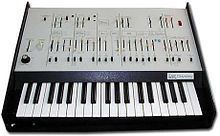Founder Alan R. Pearlman | Founded 1969 | |
 | ||
Arp quadra
ARP Instruments, Inc. was an American manufacturer of electronic musical instruments, founded by Alan Robert Pearlman in 1969. Best known for its line of synthesizers that emerged in the early 1970s, ARP closed its doors in 1981 due to financial difficulties. The company earned a reputation for producing excellent sounding, innovative instruments and was granted several patents for the technology it developed. Almost three and a half decades after it closed its doors, the company's second flagship instrument, the ARP Odyssey, has been brought back into production by Korg, working in collaboration with David Friend, Alan Pearlman's co-founder at ARP.
Contents
History
Alan Pearlman was an engineering student at Worcester Polytechnic Institute, Massachusetts in 1948 when he foresaw the coming age of electronic music and synthesizers. He wrote:
"The electronic instrument's value is chiefly as a novelty. With greater attention on the part of the engineer to the needs of the musician, the day may not be too remote when the electronic instrument may take its place ... as a versatile, powerful, and expressive instrument."Following 21 years of experience in electronic engineering and entrepreneurship, Alan Pearlman founded ARP Instruments in 1969 with US$100,000 of personal funds and a matching amount from investors, with fellow engineering graduate David Friend on board from the beginning as the co-founder of the company.
Throughout the 1970s, ARP was the main competitor to Moog Music and eventually surpassed Moog to become the world's leading manufacturer of electronic musical instruments. There were two main camps — the Minimoog players and the ARP Odyssey/ARP 2600 players — with most proponents dedicated to their choice, although some players decided to pick and choose between the two for specific effect, as well as many who dabbled with products produced by other manufacturers. Notably, the ARP 2500 was featured in the hit movie Close Encounters of the Third Kind; ARP's Vice President of Engineering, Phillip Dodds, was sent to install the unit on the movie set and was subsequently cast as Jean Claude, the musician who played the now famous 5-note sequence on the huge synthesizer in an attempt to communicate with the alien mothership.
The demise of ARP Instruments was significantly influenced by the ill-fated decision to invest a significant amount of capital in the development of the ARP Avatar, a synthesizer module virtually identical to the ARP Odyssey sans keyboard and intended to be played by a solid body electric guitar via a specially-mounted hexaphonic guitar pickup whose signals were then processed through discrete pitch-to-voltage converters. Although an excellent, groundbreaking instrument by all accounts, the Avatar failed to sell well. ARP Instruments was never able to recoup the research and development costs associated with the Avatar project and, after several more attempts to produce successful instruments such as the ARP Quadra, ARP 16-Voice & 4-Voice Pianos, and the ARP Solus, the company finally declared bankruptcy in 1981.
During the liquidation process, the company's assets and the rights to the manufacture of the 4-Voice Piano and also the prototype ARP Chroma - the company's most sophisticated instrument design to date - were sold to CBS Musical Instruments for the total sum of $350,000. The project was completed at CBS R&D, and the renamed Rhodes Chroma was produced from 1982 to late 1983. The instrument is notable for a very flexible voice architecture; 16-note polyphony; a high-quality weighted, wooden keyboard action; pioneering use of a single slider parameter editing system (subsequently implemented on the Yamaha DX7); and the inclusion of a proprietary digital interface system that predated MIDI.
The company's (second) flagship instrument, the ARP Odyssey, has been revived in 2015, by Korg developing in collaboration with ARP's co-founder David Friend. The ARP2600 is currently available as a virtual instrument from the French company Arturia and the Arp Odyssey is available in a modified form as the Ohm Force Oddity, updated by GForce Software to a polyphonic version (the Oddity 2).
Product highlights
Notable clients
Some notable ARP users and endorsers include:
(in alphabetically order of group or family name)